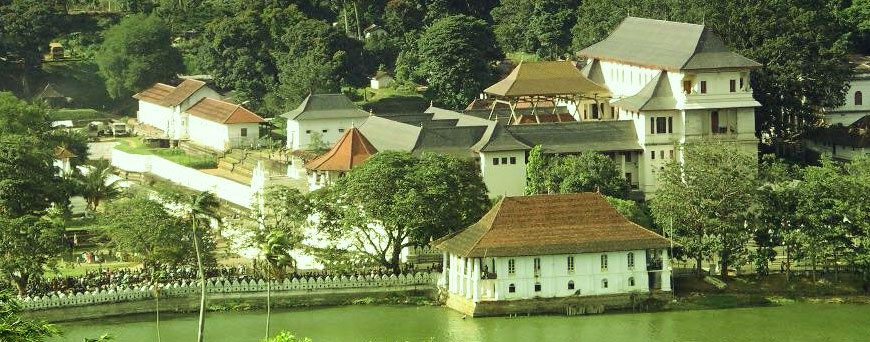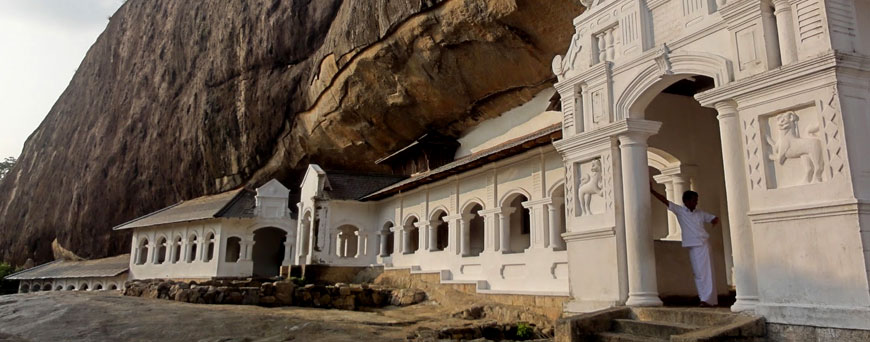

Sigiriya
Sri Lankan architectural tradition is well displayed at Sigiriya, the best preserved city centre in Asia from the first millennium with its combination of buildings and gardens with their trees, pathways, water gardens, the fusion of symmetrical and asymmetrical elements, use of varying levels and of axial and radial planning.
The Complex consists of the central rock, rising 200 meters above the surrounding plain, and the two rectangular precincts on the east (90 hectares) and the west (40 hectares), surrounded by two moats and three ramparts.
The plan of the city is based on a precise square module. The layout extends outwards from co-ordinates at the centre of the palace complex at the summit, with the eastern and western axis directly aligned to it.
The water garden, moats and ramparts are based on an echo plan duplicating the layout and design on either side. This city still displays its skeletal layout and its significant features.
3 km from east to west and 1 km from north to south, it displays the grandeur and complexity of urban-planning in 5th century Sri Lanka.

Kandy
Located in Kandy, long a center of the Buddhist faith, the stunning 17th-centuryTemple of the Tooth (Sri Dalada Maligawa) is believed to house the left upper canine tooth of the Lord Buddha himself. This precious relic attracts white-clad pilgrims, bearing lotus blossoms and frangipani, every day.
According to legend, the tooth was taken from the Buddha as he lay on his funeral pyre. It was smuggled to Sri Lanka in 313 AD, hidden in the hair of Princess Hemamali who fled the Hindu armies besieging her father's kingdom in India.
It immediately became an object of great reverence and was enshrined in a series of nested jeweled reliquaries. The tooth was brought out for special occasions and paraded on the backs of elephants, which are sacred to the Buddha. where it survived numerous attempts to capture and destroy it.
When the capital was moved to Kandy, the tooth was taken to the new city and placed in temples built to honor it. The temple was originally built under Kandyan kings between 1687 and 1707, but later severely damaged during the 18th-century colonial wars against the Portugese and Dutch.
After the wars, the original wooden structures were restored in stone.

Dabulla
Dambulla is mostly famous for its Dambulla rock temple consisting of five cave temples constructed in the 1st Century BC. Today the temple is a World Heritage Site which contains many statues and paintings dating back to the 12 the century and some of the latest one of 18th Century.
Dedicated as a UNESCO World Heritage site in 1991, Dambulla Cave Temple (or the Golden Temple of Dambulla) is the largest and best-preserved cave temple complex in Sri Lanka.
Situated in Dambulla, Sri Lanka in a region which includes more than 80 caves, Dambulla Cave Temple features 5 well-preserved caves, each of which houses ancient statues of the Buddha and historic artwork depicting the Buddha's life.
The Dambulla Cave Temple grounds also features a functioning Buddhist Monastery dating back to the third and second centuries B.C. The construction and modern maintenance of the Dambulla Cave Temple occurred along the following rough time-line: 7th to 3rd century BC: Early inhabitants 1st century BC: Paintings and statues 5th century AD: The stupa was built 12th century AD: Addition of the statues of Hindu gods 18th century AD: Most of what we see today 19th century AD: An additional cave and some repainting 20th century AD: UNESCO restoration and lighting

Sinharaja
Sinharaja Forest Reserve is a national park and a biodiversity hotspot in Sri Lanka. It is of international significance and has been designated a Biosphere Reserve and World Heritage Site by UNESCO.
The hilly virgin rainforest, part of the Sri Lanka lowland rain forests ecoregion, was saved from the worst of commercial logging by its inaccessibility, and was designated a World Biosphere Reserve in 1978 and a World Heritage Site in 1988.
The reserve's name translates as Kingdom of the Lion. The reserve is only 21 km (13 mi) from east to west, and a maximum of 7 km (4.3 mi) from north to south, but it is a treasure trove of endemic species, including trees, insects, amphibians, reptiles, birds and mammals.
Because of the dense vegetation, wildlife is not as easily seen as at dry-zone national parks such as Yala.
There are about 3 elephants and the 15 or so leopards are rarely seen. The commonest larger mammal is the endemic Purple-faced Langur.
An interesting phenomenon is that birds tend to move in mixed feeding flocks, invariably led by the fearless Greater Racket-tailed Drongo and the noisy Orange-billed Babbler. Of Sri Lanka's 26 endemic birds, the 20 rainforest species all occur here, including the elusive Red-faced Malkoha, Green-billed Coucal and Sri Lanka Blue Magpie.
Reptiles include the endemic Green pit viper and Hump-nosed vipers, and there are a large variety of amphibians, especially tree frogs.
Invertebrates include the endemic Common Birdwing butterfly and the inevitable leeches. Peaks Pinipitigala Mulawella Access ways Kudawa entrance - Colombo --> Kalawana --> Kudawa Pitadeniya Entrance - Galle or Matara --> Deniyaya --> Pitadeniya Morning Side Entrance -- Galle or Matara --> Deniyaya --> Morning Side Estate






